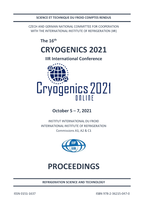
IIR document
Analysis of the freezing mechanism in LNG regasification heat exchangers used in mobile applications.
Number: 0053
Author(s) : CHOROWSKI M., STANCLIK M., KIELAR J., BRENK A., ROGALA Z., MALECHA Z.
Summary
The paper presents the results of the analysis of the freezing mechanism in a shell-and-tube heat exchanger heated with a water-glycol mixture used for LNG regasification. While designing the exchanger in the overheater area is not difficult, the theoretical models available in this topic correspond very well with the experiment, the correct design of the vaporizer zone is quite a challenge. The most important element is the correct modeling of the LNG boiling mechanism. For this purpose, on the basis of available literature data, a methane boiling curve was developed, which was then used to analyze the mechanism of ice accretion on the exchanger tubes for various construction and operational parameters. The analysis was performed both analytically and numerically in the OpenFoam software. The influence of exchanger geometry, heating medium temperature, LNG and WG flow streams as well as glycol concentration in the mixture were analyzed. The developed models were then experimentally validated. On this basis, the heat exchanger, which is partially resistant to the risk of freezing in the event of temporary failure of the heating medium circulation, has been designed.
Available documents
Format PDF
Pages: 12
Available
Public price
20 €
Member price*
Free
* Best rate depending on membership category (see the detailed benefits of individual and corporate memberships).
Details
- Original title: Analysis of the freezing mechanism in LNG regasification heat exchangers used in mobile applications.
- Record ID : 30029034
- Languages: English
- Source: Cryogenics 2021 online. Proceedings of the 16th IIR International Conference, October 5-7, 2021.
- Publication date: 2021/10/05
- DOI: http://dx.doi.org/10.18462/iir.cryo.2021.0053
- Document available for consultation in the library of the IIR headquarters only.
Links
See other articles from the proceedings (36)
See the conference proceedings
Indexing
-
Themes:
LNG and LPG;
Evaporators, condensers and other heat exchangers - Keywords: LNG; Heat exchanger; Freezing; Regasification; Design; Vapour; Methane; Expérimentation
-
Numerical investigation on flow boiling charact...
- Author(s) : LI J., HU H., HAN W., et al.
- Date : 2019/08/24
- Languages : English
- Source: Proceedings of the 25th IIR International Congress of Refrigeration: Montréal , Canada, August 24-30, 2019.
- Formats : PDF
View record
-
Development of LNG Vaporization Systems Applyin...
- Author(s) : KATSURA T., SHOJI Y., AKAI H., NAGANO K., SHISHIDO J., ISHIKAWA M., YASHIMA Y., TANIFUJI K.
- Date : 2021/08/31
- Languages : English
- Source: 13th IEA Heat Pump Conference 2021: Heat Pumps – Mission for the Green World. Conference proceedings [full papers]
- Formats : PDF
View record
-
A distributed parameter model for spiral wound ...
- Author(s) : WANG T., DING G., CHEN J., et al.
- Date : 2014/08/02
- Languages : English
- Source: 11th IIR Gustav Lorentzen Conference on Natural Refrigerants (GL2014). Proceedings. Hangzhou, China, August 31-September 2, 2014.
- Formats : PDF
View record
-
LNG-relevant experience with plate-fin exchangers.
- Author(s) : CLARKE R. H.
- Date : 2003/08/17
- Languages : English
- Source: 21st IIR International Congress of Refrigeration: Serving the Needs of Mankind.
- Formats : PDF
View record
-
Impact of sea cooling water management and heat...
- Author(s) : YAN K. S., et al.
- Date : 2004/03/21
- Languages : English
- Source: LNG 14. Proceedings of the 14th international conference and exhibition of liquefied natural gas [CD-ROM].
View record
